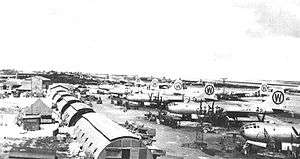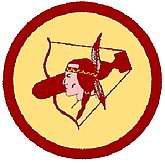482nd Attack Squadron
The 482d Attack Squadron is a United States Air Force unit, stationed at Shaw Air Force Base, South Carolina, where it is the operational squadron of the 25th Attack Group, operating unmanned aerial vehicles.
| 482d Bombardment Squadron | |
|---|---|
 505th Bombardment Group B-29 Superfortresses at North Field, Tinian | |
| Active | 1917–1919; 1925–1942; 1944–1946; 2018–present |
| Country | |
| Branch | |
| Role | Unmanned aerial vehicle |
| Part of | Air Combat Command |
| Garrison/HQ | Shaw Air Force Base, South Carolina |
| Engagements | World War I Pacific Ocean Theater[1] |
| Decorations | Distinguished Unit Citation[1] |
| Insignia | |
| 482d Attack Squadron emblem (approved 16 December 1944)[1] |  |
The first predecessor of the squadron was organized in 1917 as the 70th Aero Squadron. After being redesignated as the 482d Aero Squadron, it deployed to France as a construction unit, returning to the United States in 1919, where it was demobilized.
The second predecessor of the squadron was the 482d Bombardment Squadron, which was constituted in the Organized Reserve in 1924. The two units were consolidated in 1936 and, along with other reserve units disbanded in May 1942, shortly after the United States entered World War II.
In 1944, the 482d Bombardment Squadron, Very Heavy was activated and assigned to the 505th Bombardment Group. Shortly after it was activated, the two 482d Bombardment Squadrons were consolidated. After serving as a strategic bombing unit in the Pacific with Boeing B-29 Superfortresses, it was inactivated at Clark Field, Philippines in June 1946.
History
World War I
The first predecessor of the squadron was established at Kelly Field, Texas in August 1917 as the 70th Aero Squadron.[note 1] While at Camp Morrison, Virginia, the squadron was renumbered along with other construction units as the 482d Aero Squadron. The squadron was a civil engineering organization at the Western Front constructing airfields and related facilities in the Zone of Advance from its arrival in France in March 1918 until the Armistice on 11 November. It remained in France until early 1919 when it returned to the United States and was demobilized at Garden City, New York.[1]
Organized reserves
The 482d Bombardment Squadron was organized at Baltimore, Maryland as a reserve unit in March 1925. It was inactivated in July 1929. The unit was consolidated with the 482d Aero Squadron in 1936, but remained in inactive status until the end of May 1942, when it was disbanded along with all other Organized Reserve units.[2]
B-29 Superfortress operations against Japan
The second 482d Bombardment Squadron was activated at Dalhart Army Air Field, Texas in March 1944 as a Boeing B-29 Superfortress very heavy bombardment squadron. The following month, it was consolidated with the reserve squadron that had been disbanded in 1942. When training was completed moved to North Field (Tinian) in the Mariana Islands of the Central Pacific Area in January 1945 and assigned to XXI Bomber Command, Twentieth Air Force. Its mission was the strategic bombardment of the Japanese Home Islands and the destruction of its war-making capability.
Flew "shakedown" missions against Japanese targets on Moen Island, Truk, and other points in the Carolines and Marianas. The squadron began combat missions over Japan on 25 February 1945 with a firebombing mission over Northeast Tokyo. The squadron continued to participate in wide area firebombing attack, but the first ten-day blitz resulting in the Army Air Forces running out of incendiary bombs. Until then the squadron flew conventional strategic bombing missions using high explosive bombs.
The squadron continued attacking urban areas with incendiary raids until the end of the war in August 1945, attacking major Japanese cities, causing massive destruction of urbanized areas. Also conducted raids against strategic objectives, bombing aircraft factories, chemical plants, oil refineries, and other targets in Japan. The squadron flew its last combat missions on 14 August when hostilities ended. Afterwards, its B 29s carried relief supplies to Allied prisoner of war camps in Japan and Manchuria.
Squadron was largely demobilized on Tinian during the fall of 1945. Remained in Western Pacific, assigned to Twentieth Air Force. Moved to Clark Field in the Philippines in March 1946. Inactivated at Clark Field on Luzon on June 15, 1946; its low-hour aircraft flown to storage depots in the United States.
Lineage
- 482d Aero Squadron
- Organized as the 70th Aero Squadron on 13 August 1917
- Redesignated 482d Aero Squadron (Construction) on 1 February 1918
- Demobilized on 8 February 1919
- Reconstituted and consolidated with the 482d Bombardment Squadron on 2 December 1936[1][2]
- 482d Bombardment Squadron
- Constituted as the 482d Bombardment Squadron on 31 March 1924 and allotted to the reserve
- Activated in March 1925
- Inactivated 23 July 1929[2]
- Consolidated with the 482d Aero Squadron on 2 December 1936[2]
- Disbanded on 31 May 1942
- Reconstituted and consolidated with the 482d Bombardment Squadron, Very Heavy on 21 April 1944[1]
- 482d Attack Squadron
- Constituted as the 482d Bombardment Squadron, Very Heavy on 28 February 1944
- Activated on 11 March 1944
- Consolidated with the 482d Bombardment Squadron on 21 April 1944
- Inactivated on 30 Jun 1946
- Redesignated 482d Attack Squadron on 13 February 2018
- Activated on 27 February 2018[1]
Assignments
- Unknown, 15 August 1917 – March 1918
- Advance Section, Service of Supply, March 1918 – December 1918
- Unknown, December 1918 – 8 February 1919
- Allotted to Third Corps Area, 31 March 1924 – 31 May 1942
- 347th Bombardment Group, March 1925 – 23 July 1929[2]
- 505th Bombardment Group, 11 March 1944 – 30 June 1946
- 25th Attack Group, 27 Feb 2018 – present[1]
Stations
- Kelly Field, Texas, 13 August 1917
- Camp Morrison, Virginia, 21 December 1917 - 4 March 1918
- Colombey-les-Belles Airdrome, France, 27 March 1918
- Autreville Aerodrome, France, 28 March 1918
- Trampot, France, c. 9 July 1918
- Longeaux Aerodrome (Haute-Marne), France, 22 September 1918
- Trampot, France, c. 24 October 1918
- Braux, France, c. 22 November 1918
- Pont Rousseau, 25 December 1918 – unknown
- Garden City, New York, c. 8 – 18 March 1919
- Baltimore, Maryland, c. March 1925 – 23 July 1929[2]
- Dalhart Army Air Field, Texas, 11 March 1944
- Harvard Army Air Field, Nebraska, 12 March – 6 November 1944
- North Field (Tinian), 24 December 1944 – 5 March 1946
- Clark Field, Luzon, Philippines, 14 March – 30 June 1946
- Shaw Air Force Base, South Carolina, 27 February 2018 – present[1]
Aircraft
- Boeing B-17 Flying Fortress, 1944
- Boeing B-29 Superfortress, 1944–1946[1]
See also
- List of American Aero Squadrons
References
Notes
- Explanatory notes
- A second 70th Aero Squadron was organized at the end of February 1918 at Ellington Field. Texas. It was redesignated Squadron B, Ellington Field in July 1918 and Flying School Detachment, Ellington Field in December. The detachment was demobilized in September 1919 and later (27 July 1932) consolidated with the 70th Service Squadron.
- Citations
- Haulman, Daniel L. (March 26, 2018). "Factsheet 482 Attack Squadron (ACC)". Air Force Historical Research Agency. Retrieved April 9, 2018.
- Clay,p.1520
Bibliography
![]()
- Clay, Steven E. (2011). US Army Order of Battle 1919-1941 (PDF). Vol. 3 The Services: Air Service, Engineers, and Special Troops 1919-1941. Fort Leavenworth, KS: Combat Studies Institute Press. ISBN 978-0-98419-014-0. LCCN 2010022326. OCLC 637712205. Archived from the original (PDF) on 2013-09-27. Retrieved October 16, 2012.
- Maurer, Maurer, ed. (1983) [1961]. Air Force Combat Units of World War II (PDF) (reprint ed.). Washington, DC: Office of Air Force History. ISBN 0-912799-02-1. LCCN 61060979. Retrieved December 17, 2016.
- Maurer, Maurer, ed. (1982) [1969]. Combat Squadrons of the Air Force, World War II (PDF) (reprint ed.). Washington, DC: Office of Air Force History. ISBN 0-405-12194-6. LCCN 70605402. OCLC 72556.
.png)